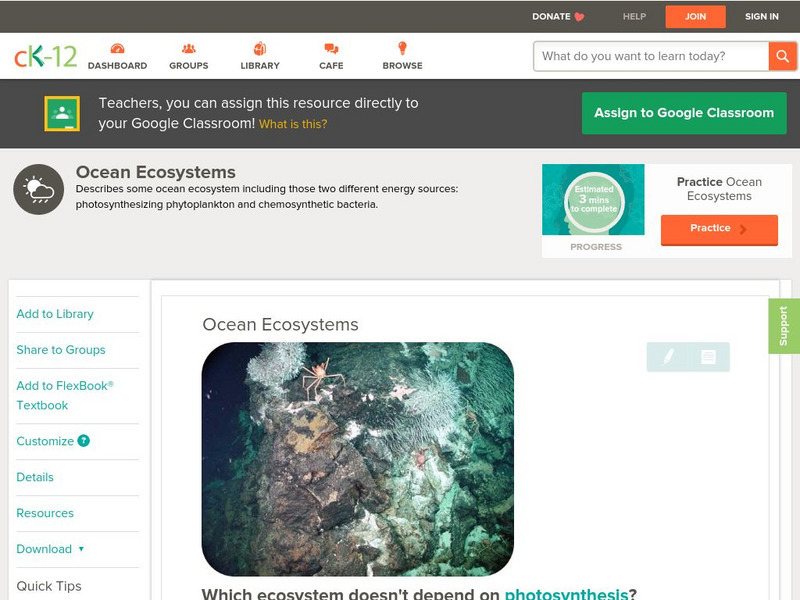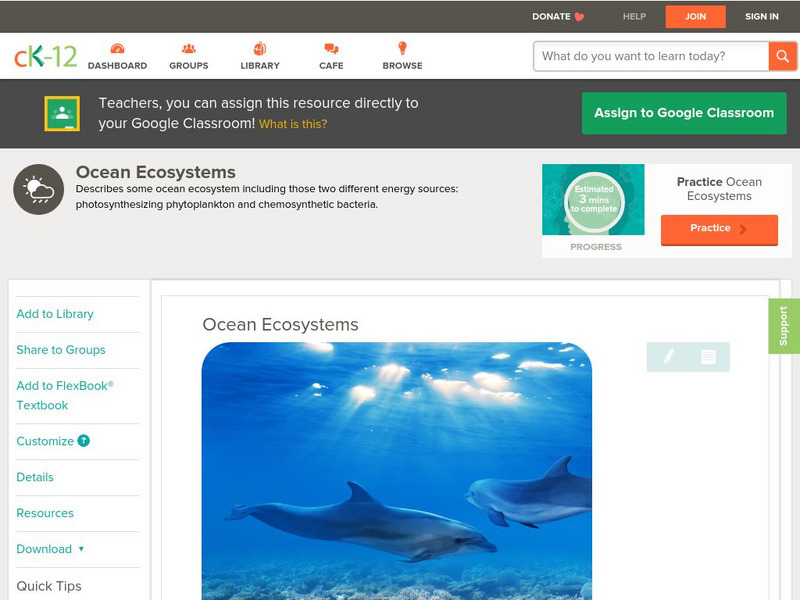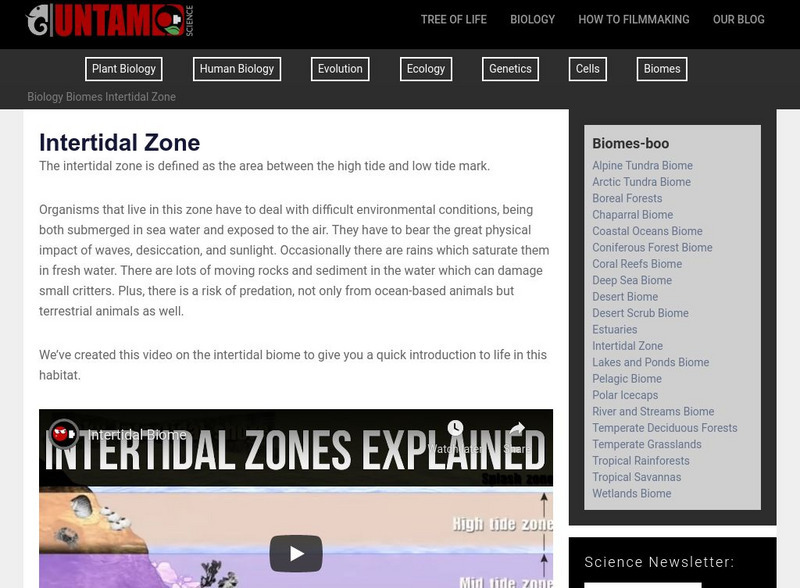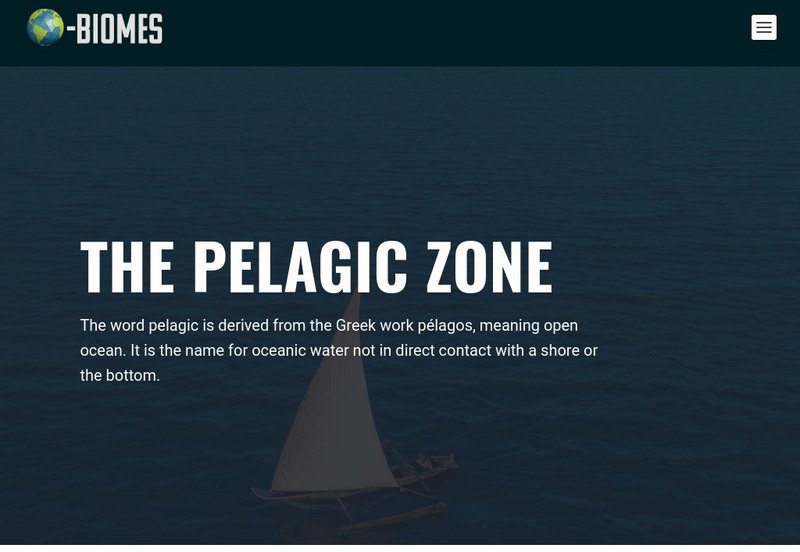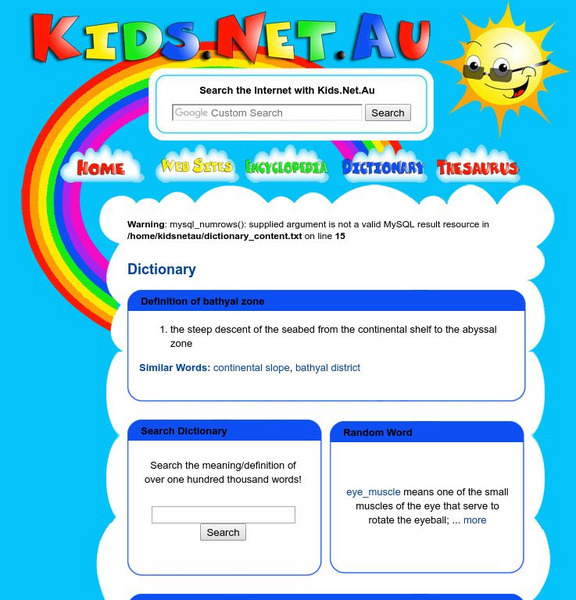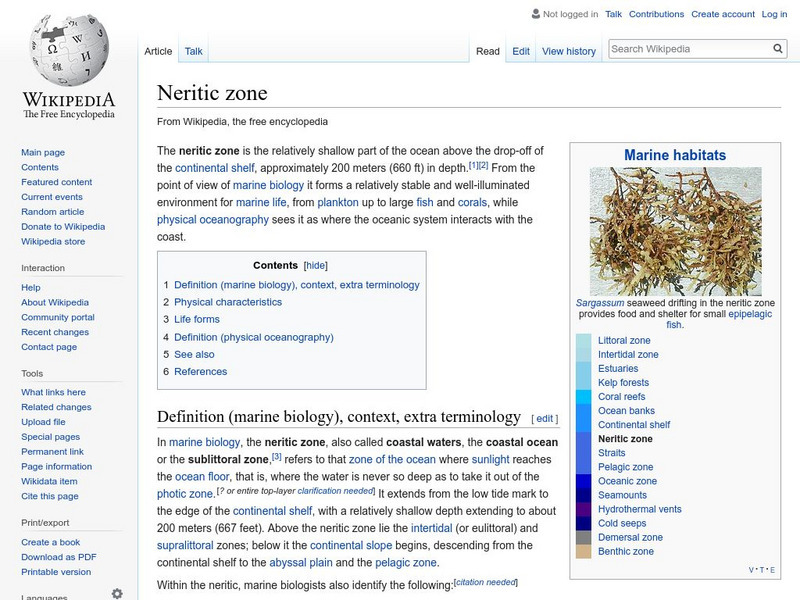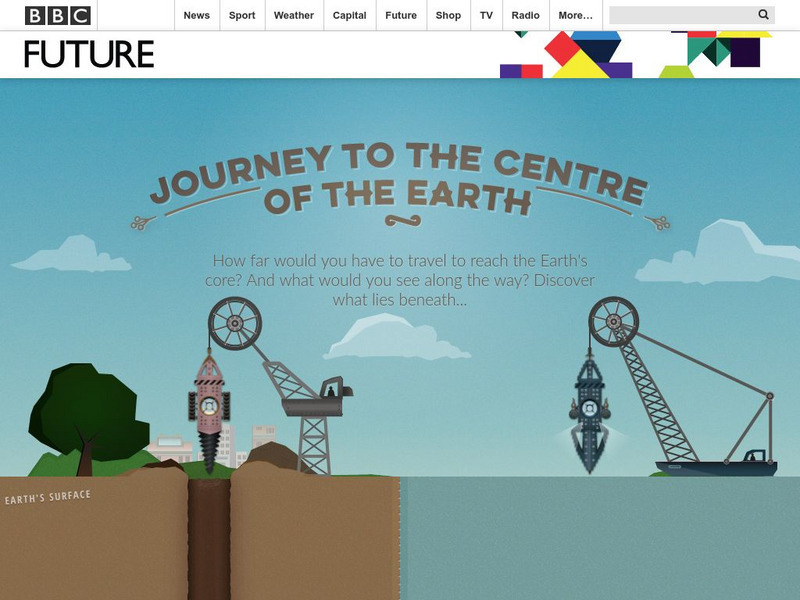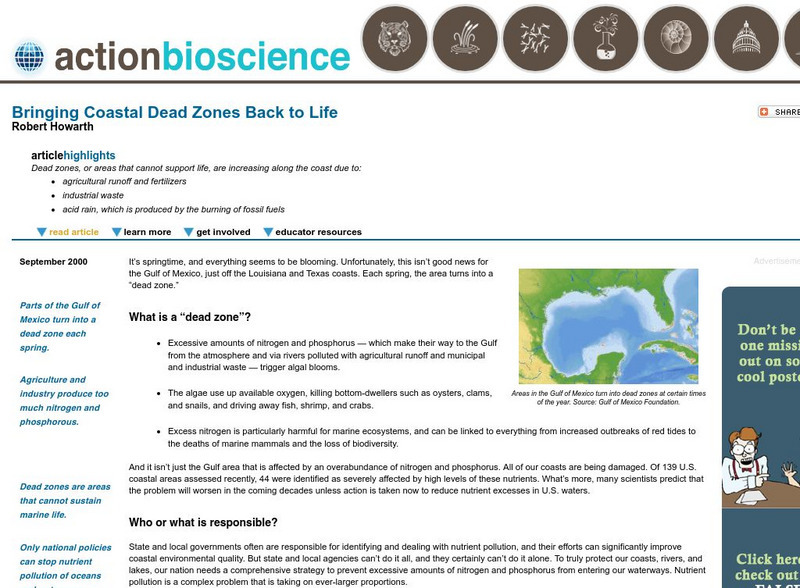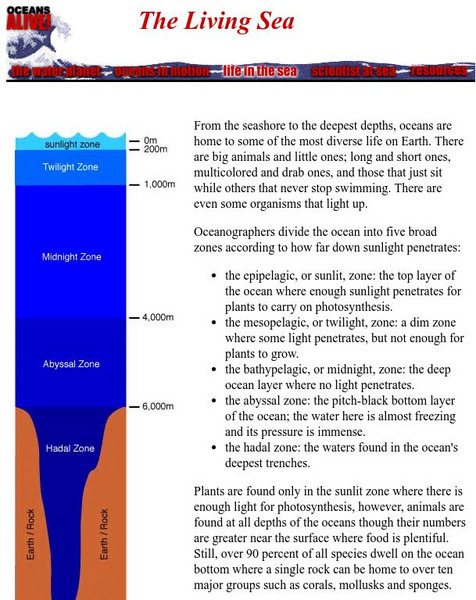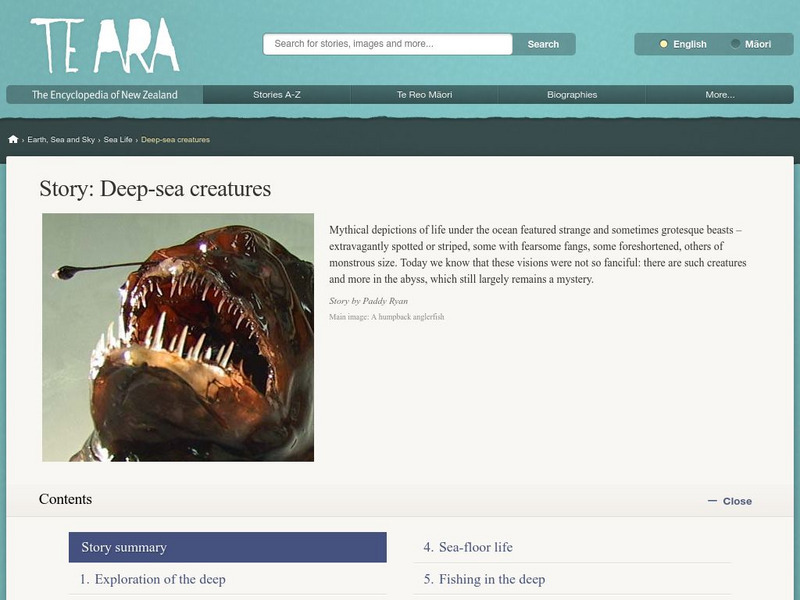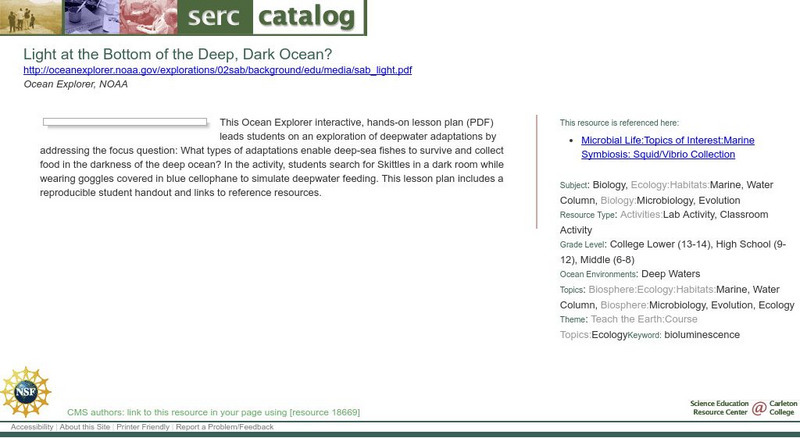Smithsonian Institution
National Museum of Natural History: Ocean Planet
Detailed website that was a companion to a 1995 traveling exhibit of the Smithsonian. Links to lesson plans and other educational materials are at the bottom of the page. Enter the exhibition to explore the world of the ocean.
CK-12 Foundation
Ck 12: Earth Science: Ocean Ecosystems
[Free Registration/Login may be required to access all resource tools.] Describes organisms found in varying ocean ecosystems.
CK-12 Foundation
Ck 12: Earth Science: Ocean Ecosystems
[Free Registration/Login may be required to access all resource tools.] Describes organisms found in varying ocean ecosystems.
National Geographic
National Geographic: Encyclopedia: Ocean Trench
Comprehensive information about deep-ocean trenches. Includes maps, a video [1:29], and a vocabulary list.
Untamed Science
Untamed Science: Biology: World Biomes: Intertidal Zone: Aquatic Biome
Learn about the flora and fauna of the intertidal aquatic zone and the characteristics that describe this aquatic biome through reading and watching video clips. [6:42]
The Wild Classroom
The Wild Classroom: Biomes of the World: Oceanic Pelagic Biome
Learn about the oceanic pelagic ecosystem. Find out about plants, animals, adaptations, and conservation efforts.
NASA
Nasa: Creeping Dead Zones
Dead zones are popping up along coastlines all over the world. Find out what they are and the causes of this destructive phenomenon.
Encyclopedia of Earth
Encyclopedia of Earth: Abyssal Zone
This in-depth resource discusses the abyssal zone of the ocean. Includes a diagram and many facts about this zone.
The Wild Classroom
The Wild Classroom: Biomes of the World: Intertidal Zone
Learn about the intertidal ecosystem. Find out about plants, animals, adaptations, and conservation efforts.
American Museum of Natural History
American Museum of Natural History: O Logy: Journey to Deep Sea Vents
Take a submersible down to the seafloor. As you descend, passing through the ocean's sunlight, twilight, and midnight zones, you can observe how temperature, pressure, and light levels change. When your submersible reaches the seafloor,...
Wikimedia
Wikipedia: Neritic Zone
Learn about the neritic zone, also called the sublittoral zone or sea floor.
BBC
Bbc Future: Journey to the Centre of the Earth
Explore deep underground and deep in the ocean to discover what lies beneath the surface. Don't stop until the final destination: the core of the Earth.
Science Struck
Science Struck: Facts About the Marine Biome
Describes the characteristics of the marine biome, the plants and animals that live in each of the four ocean zones, coral reefs and estuaries, the climate of the marine biome, and the marine food web.
American Institute of Biological Sciences
Action Bioscience: Bringing Coastal Dead Zones Back to Life
Increased amounts of nitrogen and phosphorous are leading to "dead" areas on our coastlines. Delve into the details and how to get involved with stopping this from happening.
Science Struck
Science Struck: Facts About the Aphotic (Midnight) Zone of the Ocean
The aphotic zone of the ocean receives less than one percent of sunlight penetration. It extends from between 200 to 1,000 m, or 660 to 3,300 ft, down to the seafloor. Learn about the characteristics of this zone and the adaptations the...
Missouri Botanical Garden
Missouri Botanical Garden: Temperate Oceans Light Zones
Discover the three zones in the ocean which are determined by the amount of light received from the sun. Pictures illustrate the three zones and there is a listing of the animals that live in each zone.
Science Struck
Science Struck: Interesting Facts About the Abyssal Zone
The Abyssal Zone lies deep in the ocean in the pelagic layer between 4,000 to 6,000 m or 13,000 to 19,500 ft. Learn about some of the unique life forms that call this zone their home, how they have adapted to the extreme pressure and...
Science Struck
Science Struck: A Helpful Guide to Understand the Photic Zone
The photic zone is the upper layer of the ocean where sunlight can penetrate and support photosynthesis. This article explains the characteristics of this zone, the food chain that exists there, the adaptations of the plants and animals,...
CK-12 Foundation
Ck 12: Earth Science: Ocean Ecosystems Study Guide
[Free Registration/Login may be required to access all resource tools.] This study guide summarizes key points about ocean ecosystems. Includes a few questions to check for understanding.
Museum of Science
Museum of Science, Boston: Oceans Alive: The Living Sea
Find a scale model of the five principal ocean zones, along with additional information.
Other
Encyclopedia of New Zealand: Deep Sea Creatures
Learn about the life forms that dwell deep in the ocean which is divided into four zones. These zones have similar life forms around the world.
CK-12 Foundation
Ck 12: Plix: Volcano Map: Oceanic Oceanic Convergent Plate Boundaries
[Free Registration/Login Required] Get an inside look of a subduction zone with the animation on this page. Page includes a interactive animation and a short quiz.
Science Education Resource Center at Carleton College
Serc: Light at the Bottom of the Deep, Dark Ocean?
What types of adaptations enable deep-sea fishes to survive and collect food in the darkness of the deep ocean? Interactive, hands-on lesson plan takes students on an exploration of deepwater adaptations by searching for Skittles in a...



